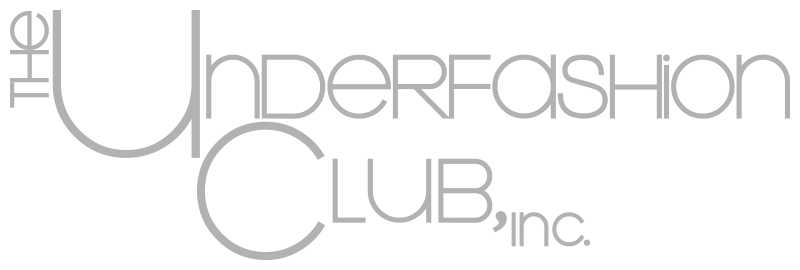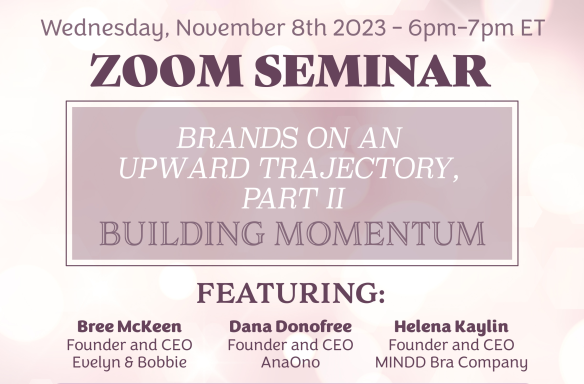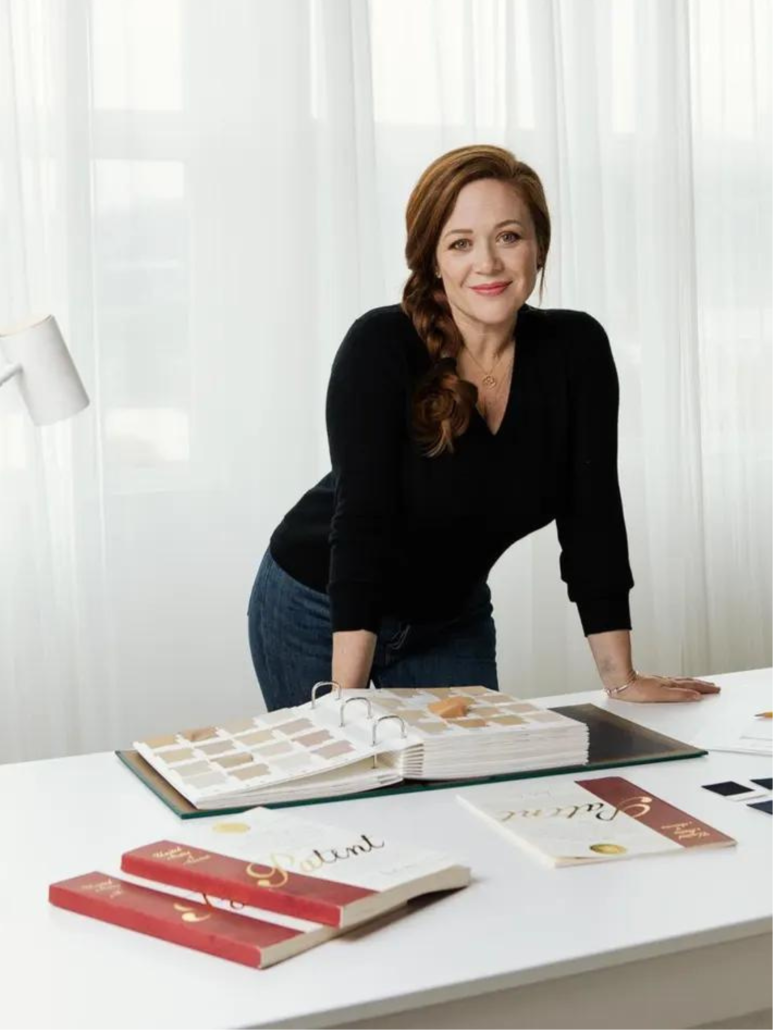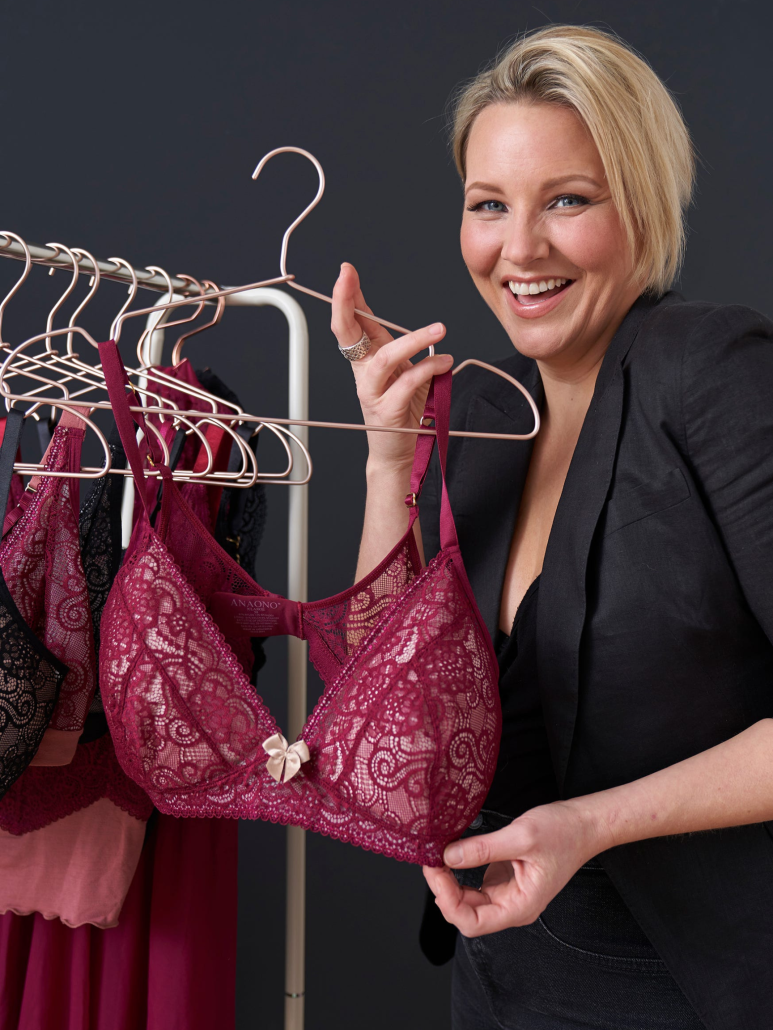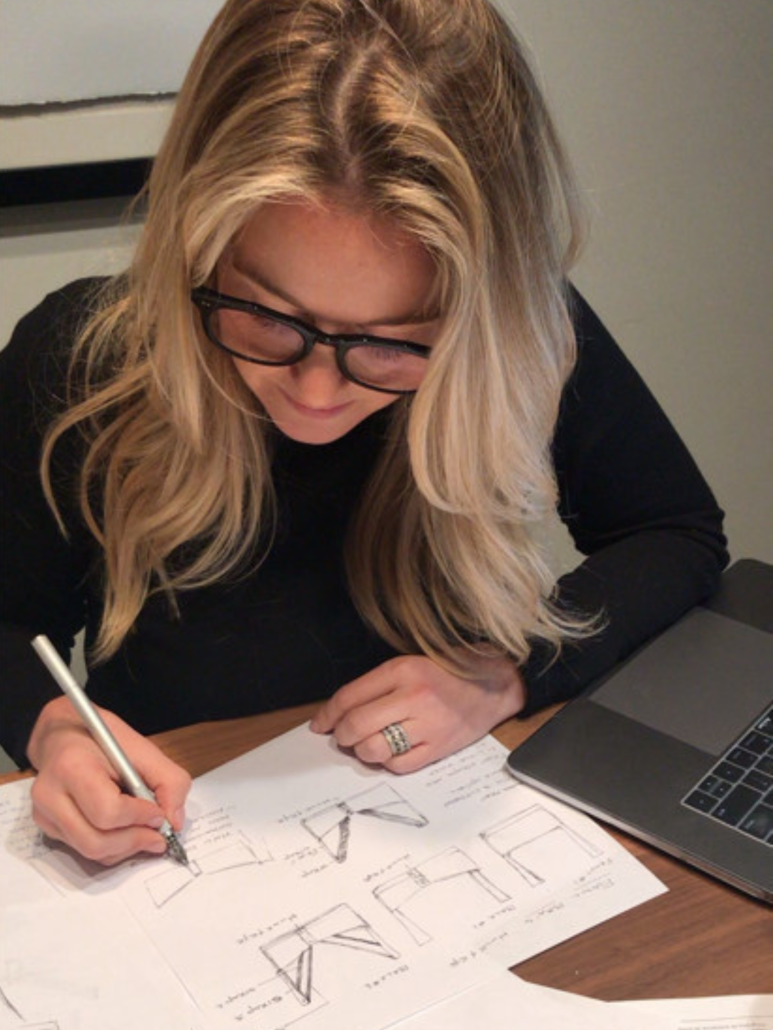On November 8th, the Underfashion Club’s webinar series “Brands On An Upward Trajectory” featured three intimate apparel entrepreneurs, who shared their expertise and experiences with Club members. For “Part II: Building Momentum” we welcomed back Bree McKeen of Evelyn & Bobbie, and Dana Donofree of AnaOno, and were pleased to welcome Helena Kaylin of MINDD Bra Company to the panel! Each of these Founders/CEOs shared what inspired them to create their respective lingerie brands and the plans they developed and executed to bring innovative solutions to the industry. The first webinar in the series, “BreakOut Brands: Niche Brands on an Upward Trajectory” was held on July 12th and received such positive feedback that we were thrilled to offer another webinar on the subject!
The second webinar began with a question from a Club member addressed to all three panelists: “You have all achieved a level of success that I find aspirational, so I would like to understand how you went from creating the product to creating the business. As I get ready to launch my intimate apparel brand, I find that every step I take, I need to spend days learning and researching something new; things that I hadn’t considered when I first set up my timeline. Is there anything that you found out after the launch that you wish you had understood or prepared for earlier?”
Bree McKeen used her frustration with finding an ultra-supportive bralette design for large-breasted people to begin her brand, Evelyn & Bobbie. She started her brand because she was in pain, her posture was suffering, and she was uncomfortable due to ill-fitting bras. She recalled working in Venture Capital and being pitched by yet another machine learning company, inspiring the moment where she wondered, “How is it that we live in a world where we have artificial intelligence, and I don’t have a comfortable bra?” Evelyn & Bobbie was created to provide bras that serve as gear for life. Not only does it look great in the boardroom, but it’s also comfortable enough to lounge and sleep in.
During the brand’s inception, Bree’s vision was more focused on creating a tech-forward product since the underwire that was invented in the 1930’s and has essentially been unchanged since. This clear and compelling vision was designed to attract investors and a talented team. It takes a great deal of time and money to start a business and it’s become even more difficult in the last 5 years. She stresses that it is necessary to have a clear path to your first dollar. This isn’t because profitability is the only thing that matters, but because profitability is sustainability.
Brands don’t start profitable, but get to profitability. Early on, Bree made many decisions that didn’t consider profit first. They were too deep in the grand vision and not practical enough. The brand needs to make more than it spends, full-stop, or it’s not sustainable. In fact, her day-1 business plan is almost not relevant anymore, but the vision is! She wears the bra that she dreamt of every day now, though there was a lot of nuance in the vision that got scraped down to the barebones of what she wanted her day to feel like. She admits that her business plan could not have turned out more differently in many ways, but it’s a living document that is constantly being revised. Even so, it is critical to have a detailed strategic plan and product strategy that can be honed as you and your team learn.
Her advice is to have a grand vision that gets people on board and inspires you to wake up on those hard mornings where you don’t want to get out of bed because everything is so hard. The vision is going to be motivating for you but at the end of the day, you’re running a business. That plan will be your starting point, and if it doesn’t work out in a few months, she suggests writing it down to critically analyze how the plan should be adjusted. It will change all the time with the goal of finding how you can make more money than you’re going to spend.
There’s a culture change happening, shifting the expectation for women to stay silent and look pretty into the revelation that comfort is truly valuable, and people are willing to pay for it. Authenticity is what people long for and smaller brands by passionate people who solve a real problem have a shot in this world where big corporations are dominant. Bree stated that best side of social media is that there are bits and pieces of authenticity in there, but that chapter is closing. She sees the future veering away from “fueling the Meta machine,” and she’s looking forward to what’s coming next. Current social media is designed to make money off of us and they will always tweak the algorithm to make sure we spend as much as possible. How do we push beyond social media as the sole means of customer acquisition?
Bree feels that none of us truly know what the future of AI looks like, but she believes it will be a big part of optimizing e-commerce efficiency. It has been helpful for managing her brand’s Google Ad efficiency and ChatGPT has been fun for aiding in the creation of copy. For example, she asked ChatGPT to write a blog that explains to a man why a comfortable bra is important, and the results were great, hilarious, and useful! There are many ways Bree can see AI being incorporated into Evelyn & Bobbie, but it’s still very early and she is currently more concerned with how to utilize print. AI is a rapidly evolving technology and may change things drastically for business owners very soon.
Dana Donofree is a breast cancer survivor whose quest for comfort after surgery seeded the AnaOno brand. She has been a fashion industry professional for over 20 years, working in roles involved in sourcing, manufacturing, production, and more. In spite of her expertise, she still needed to convince a room full of men that she was capable and able to create a business in a huge market space that wasn’t being addressed at all.
AnaOno was launched in 2014, though Dana began conceptualizing it in 2011. It took three years to get there since she was self-funding because no one thought women with breast cancer would want pretty bras. If someone goes through a mastectomy, they’ll need a medical bra, but why should it have to look like a medical device? The pain of the recovery and healing process makes comfort a priority as well. Because investors would tell her that she didn’t have a good business idea, Dana didn’t create a standard business. Dana took what she knew in her heart needed to be done and whether it was going to be a hobby or not, she was going to make the brand a reality with or without their support. Even so, she still recommends having a business plan while going forward with sustaining a brand!
Many of Dana’s colleagues called her crazy when she shared that she was going to start a bra company. Even a basic bra can conservatively consist of about 30 different components. If you add lace, trims, and other embellishments, it could get to be close to 50. Compare this to a T-shirt, which only has about 5 pieces on the bill of material, including the shipper box. There’s a complexity in the intimate apparel industry specifically, not only in sourcing and where you can make it around the globe, but also in how you execute. It can be so hard to start a lingerie business if you are not a bespoke, one-of-a-kind, couture lingerie line, it gets very complicated from a production/manufacturing/sourcing channel. When creating a business, sourcing mistakes can be the most expensive ones you make. If a design is off by one or two centimeters, your entire lot could be trash. These are the risks that you take when starting a business.
Some of the best advice Dana received when starting her brand was “be where your customers are.” At the time of launching, people weren’t shopping online nearly as much though it was primed for her business. Getting accessibility to a mastectomy garment following amputation of your breasts to save your life was beyond challenging. Recognizing that there were few places for breast cancer survivors to go in 2014, AnaOno began in e-commerce to be as accessible as possible. Today, AnaOno is being stocked by Victoria’s Secret! Dana had gone there to look for a mastectomy bra years ago and couldn’t find one, and has become the one to create the product and brand that’s stocked there today, making it more accessible than ever!
Dana feels like AI can only be as smart as the creator, as it doesn’t think for itself but helps to execute. She is excited for AI’s potential to unlock bandwidth and allow her to take her creation to the next level. The mind of a successful entrepreneur is progressive and capable of changing, altering, and understanding things at a fast pace because that’s what you need to keep a business afloat. Everything is changing and you need to be able to re-strategize an entire business at the drop of a needle. Learning and evolving is part of the job as an entrepreneur because something changes every single day.
Helena Kaylin began her journey in 2005 as part of an innovative design group with Victoria’s Secret, charged with finding new market technologies. She recognized during this tenure that there wasn’t even a DD option at the time. She held positions at other companies, including Lululemon, who would not carry large cup sizes at the store because they looked “too big” on the sales rack. Frustrated with the constant uphill battle she was facing; she began her mission to get a correct fitting bra on the backs of as many women as possible. By 2021, Helena became the first wholesale customer of the Victoria’s Secret brand!
With her background in intimates, Helena wrote one slide with a perspective that disconnected everything she knew in the past with the purpose of reimagining the future of bras. If we could have wireless headphones in 2018, we should also be able to have great wire-free bras! From the original “aha” moment, that one slide reminds her of the reason why she embarked on the difficult process of creating and running a brand, keeping her motivated throughout the years. Helena founded MINDD in 2019 and launched by 2020.
Risk assessment during a global pandemic is tricky business and can involve some criticism. Helena’s inherent belief was that the technology is out there, and we just had to fine-tune it to not be reliant on something from the 1930’s, as Bree said. She believed that wire-free was the future. Fast-forward a bit and we’re addressing an audience that’s working from home and desiring a wire-free experience! Sustaining a brand will require eliminating the noise and stay laser-focused on what you want to achieve. The criticism might come from the people closest to you, but just know that the people who love you want to keep you safe.
When creating a product, you want to have plans for what you are charging for the product, how you will get it to market, cost-effectiveness, and how you’ll be marketing it. While Helena can see the vision and pathway of MINDD in her head, making sure there is someone on your team who can manage an excel spreadsheet is the best support mechanism for keeping the plan intact. Covid and technological changes such as iOS14 drastically shifted how marketing is done, which has caused pain for many startups. Being agile and making decisions quickly will be helpful while what the future looks like.
Tie the grand vision to profitability and the goal of making money. If you have a vision to be in support of women, you want to keep the vision going for as long as possible! The goal is to make an amazing product that customers keep coming back to, utilizing marketing to spread via word of mouth. The #1 thing that kills a startup is cash. Helena has been invested in connecting with customers in live environments such as trade shows since the beginning of 2022, turning off all of her digital marketing campaigns. This has been a shift since MINDD’s launch in 2020, where e-commerce was the only way to meaningfully reach customers. Lately, her impression of digital marketing has been a sea of sameness where acquiring customers is very expensive. She sees a need to return to the old ways of marketing, such as print which has always been successful for her brand. It’s like going “back to the future!”
With regards to AI, Helena sees that machine learning is an integral part of the future of technology. She is more invested in craftsmanship and thinking through problems, but if AI could make her a more efficient business owner, then she could look forward to its future utility!
Thank you to these three wonderful speakers for making this such a fantastic and inspiring discussion for people in the bra business! We hope everyone who tuned in found it helpful, and if you missed it, don’t worry! Underfashion Club members can watch the entire webinar on YouTube.
